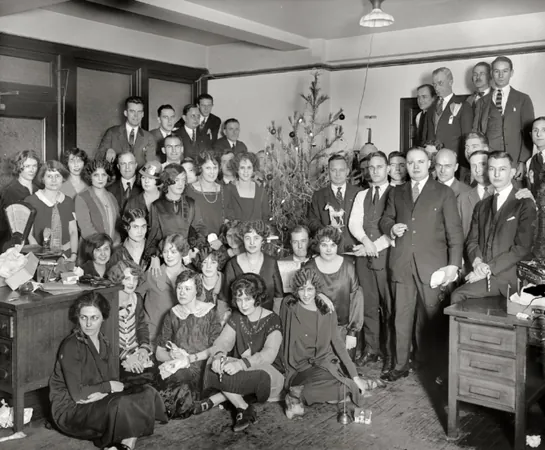
A Century of Predictions: What a Fargo Editor Got Right and Wrong About Our Future
2025-01-01
Author: Lok
A Century of Predictions: What a Fargo Editor Got Right and Wrong About Our Future
As we approach the end of 2024, year-end lists have become a social media phenomenon and a staple of television programming. From the most acclaimed films to quirky headlines like 'Ten Times Animals Predicted the Stock Market,' it seems everyone is interested in reflecting on the past. But what if we looked back even further? Today, let’s journey one hundred years back to January 1, 1925, to unearth predictions made about the future and weigh them against our reality today.
During my recent exploration of The Fargo Daily Tribune's New Year’s issue from that day, I found a rich tapestry of insights reflecting both the hopes and realities of the 1920s. One headline stood out starkly: 'Sane Politics Prevail.' In an era when political discord seems ubiquitous, this gentle optimism prompts us to reflect on the stability and trust that characterized American politics under President Calvin Coolidge, who successfully appealed to a populace eager for order.
Besides political musings, the paper noted the death of Cass County pioneer Sarah Russel, a reminder of the region’s humble beginnings before North Dakota achieved statehood. In contrast, a candy store owner faced the law for repeatedly selling cigarettes to minors—a cautionary tale that reveals ongoing societal challenges.
On the business front, advertisements shouted about spectacular sales—silk dresses for a mere $6.49 and cough syrup marketed as delicious. This glimpse into consumer culture and commerce is both amusing and revealing.
However, it was the predictions for the future that truly caught my eye. An editorial titled 'Hold Your Horses! The Elephants are Coming' reflected an enthusiasm for the coming decades, viewing the last quarter of the 19th century as tumultuous. Columnist George Ade remarked on advancements from 1900 to 1925 that would have seemed unbelievable to the earlier crowd, suggesting that future innovations only promised to astonish us further.
Here’s a breakdown of some bold predictions from 1925 and their outcomes in 2025:
1. **Fighting Bacteria**: The editor foresaw 'super-microbes or phages' annihilating bacteria. Fast forward to today, and while penicillin revolutionized medicine, bacteriophages play a vital role in medical science still trailing behind antibiotics.
2. **Living Forever?**: The notion of indefinitely prolonging life captivated imaginations. Today, though we have seen substantial increases in longevity—from an average of 58 years in 1925 to nearing 78 years in 2025—immortality remains a speculative fiction.
3. **The Evolution of Radio**: 'What will they do with radio?' they mused. A century later, we have transcended radio into television, the internet, and beyond—technologies that would bewilder a 1920s observer.
4. **Peace and International Relations**: The 1925 hope for enduring peace through the League of Nations did not materialize, leading to the Second World War. However, its legacy inspired the formation of the United Nations, although global conflict sadly persists.
5. **Life on Mars**: The curiosity about Martian life has evolved significantly. Robotic missions have mapped its surface and searched for signs of past life, but we still await human footprints on the Red Planet.
6. **Harnessing Atomic Energy**: With foresight into atomic developments, the editor accurately predicted humankind’s ongoing engagement with atomic physics, resulting in both nuclear power as an energy source and ongoing debates regarding its safety and impact.
Anticipating the future through today’s lens, we can speculate on what life might look like in 2125.
Experts are already raising possibilities, including:
1. **Enhanced Human Life**: Advances in genetics could allow for significantly longer lifespans, potentially eliminating age-related diseases.
2. **AI and Robotics Integration**: A future where robots are commonplace, performing most routine jobs, freeing us for creativity and leisure.
3. **Space Colonization**: By 2125, we could witness thriving communities on Mars, the Moon, and other celestial bodies.
4. **Climate Change Consequences**: Countries may face severe existential threats if current environmental trends don’t change, with some regions becoming uninhabitable.
5. **Evolving Philosophies**: Ethical dilemmas surrounding artificial intelligence and biotechnology could dominate debates, reflecting our moral evolution.
As we peer into this intricate tapestry of past and future, it is evident that while some predictions remain on the fringes of reality, others have transformed into the world we inhabit today. The question remains: how well will our dreams and innovations hold up in the face of time? For the thinkers of 2125, it’s your turn to assess how we’ve done.
 Brasil (PT)
Brasil (PT)
 Canada (EN)
Canada (EN)
 Chile (ES)
Chile (ES)
 Česko (CS)
Česko (CS)
 대한민국 (KO)
대한민국 (KO)
 España (ES)
España (ES)
 France (FR)
France (FR)
 Hong Kong (EN)
Hong Kong (EN)
 Italia (IT)
Italia (IT)
 日本 (JA)
日本 (JA)
 Magyarország (HU)
Magyarország (HU)
 Norge (NO)
Norge (NO)
 Polska (PL)
Polska (PL)
 Schweiz (DE)
Schweiz (DE)
 Singapore (EN)
Singapore (EN)
 Sverige (SV)
Sverige (SV)
 Suomi (FI)
Suomi (FI)
 Türkiye (TR)
Türkiye (TR)
 الإمارات العربية المتحدة (AR)
الإمارات العربية المتحدة (AR)